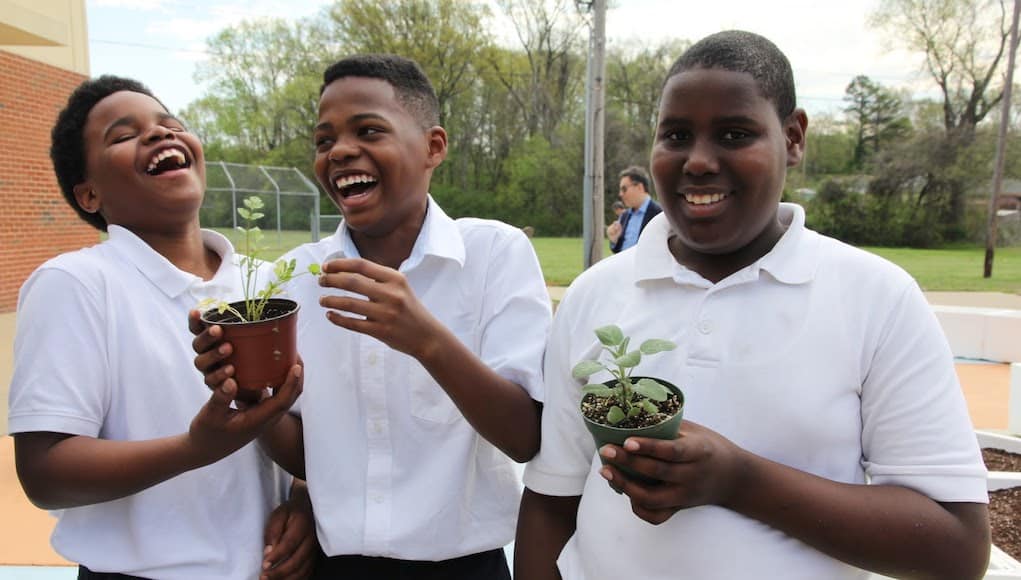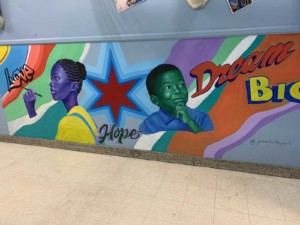Learning Gardens Provide Equity, Access and Great Food

Do you know where your food comes from? Do you know how your fruits and vegetables are grown and when they are in season? In a rush to get dinner on the table we’ve become a culture so disconnected from the food we eat. Often, we are faced with choosing cheap and processed food options over seeking out locally grown produce.
Personally, food is my love language. Its how I show people I love them and breaking bread with someone is how I feel connected. Meeting local growers at the farmers market on the weekend makes cooking even more enjoyable. From the time my daughter could stand, she joined me in the kitchen and is learning about how to eat healthily and appreciate where our food comes from. I have long appreciated community and school gardens but worried that they often didn’t connect to student learning and create a lasting impact.
When I heard about the work of Big Green I was intrigued and reached out to Kate Waller, who manages their national growth to learn more.
Big Green is ”building a national school food culture that promotes youth wellness.” Through food literacy programs and a network of Learning Gardens, students, parents and teachers are connected through robust food culture. They are currently located in seven cities in the United States, focused on underserved schools. Big Green Learning Gardens are a wonderful example of place-based education that connects community and schools with a focus on sustainability, equity and access.
 Their gardens, built in partnerships with schools are ADA accessible, inviting and exciting for students, teachers, and parents. In fact, in the schools in which they operate, they have seen a 22% increase in parent involvement because of their ability to volunteer in the learning gardens. Gardening and growing food have created a bridge for parents who may not otherwise have felt like they had a place in their children’s school.
Their gardens, built in partnerships with schools are ADA accessible, inviting and exciting for students, teachers, and parents. In fact, in the schools in which they operate, they have seen a 22% increase in parent involvement because of their ability to volunteer in the learning gardens. Gardening and growing food have created a bridge for parents who may not otherwise have felt like they had a place in their children’s school.
Big Green builds Learning Gardens that are “dynamic outdoor classrooms and productive edible gardens”. Because they appreciate that each school and community is unique, their gardens are customized for each location. Their gardens are 19 inches tall, allowing children to easily access the beds at eye level. With education at the center of their work, they also ensure the gardens include seating and share to make them attractive places for outdoor lessons.
 At each school site, a garden educator works with teachers to implement K-8 health and nutrition-based curriculum based on the science of growing of food. In high school the focus shifts to a real food lab where students design and operate a food-based business using produce from the garden.
At each school site, a garden educator works with teachers to implement K-8 health and nutrition-based curriculum based on the science of growing of food. In high school the focus shifts to a real food lab where students design and operate a food-based business using produce from the garden.
Big Green was started seven years ago and was the brainchild of Kimball Musk. After attending the French Culinary Institute, Musk knew he wanted to incorporate food into his profession but was not sure in what capacity. He was living in New York when 9/11 happened and was able to cook for the rescue workers for weeks. It was the way he was able to serve his community and it created a profound calling for him to use food as a vehicle to bring communities together.
After moving to Boulder, Colorado he started a restaurant group that was doing “Farm to Table” cooking before it was popularized in the United States. Musk saw a need to support building school gardens based on accessible design standards. He started Big Green as a way to build sustainable programs with schools with a focus on equity and access. Many of the school garden programs today are spearheaded by one staff member at a school that has a passion, but when staffing transitions happen the gardens often go unattended. There has largely been a disconnect between the garden and school curriculum as well. Musk and his team at Big Green set out to change that.
 When Big Green starts work in a city they spend about a year meeting with nonprofits, schools, businesses and city leaders. The first step to working in a new city is to secure $250,000 in Seed Funding. This allows Big Green to conduct a 1,000-hour Foundational Seed Process that includes a Needs Assessment and Feasibility Study. However, it goes beyond numbers to build strong relationships with nonprofits, school districts, and donors. This process is key to their work because it allows Big Green to create all of the infrastructures to build an impactful and sustainable non-profit in each city.
When Big Green starts work in a city they spend about a year meeting with nonprofits, schools, businesses and city leaders. The first step to working in a new city is to secure $250,000 in Seed Funding. This allows Big Green to conduct a 1,000-hour Foundational Seed Process that includes a Needs Assessment and Feasibility Study. However, it goes beyond numbers to build strong relationships with nonprofits, school districts, and donors. This process is key to their work because it allows Big Green to create all of the infrastructures to build an impactful and sustainable non-profit in each city.
Big Green is aiming to set up 100 school sites per city they are working in. They hire a team of people in each city that includes an executive director, program managers, project managers and garden educators that will work directly with the schools and gardens.
Big Green currently has 550 school gardens in seven cities, and hope to be in 10 cities in the next few years. They are reaching half a million kids a day in their Learning Gardens.
One way to join the movement is participating in Plant a Seed Day on March 20, 2019 by planting a seed in a local garden, your home, school or somewhere in your community.
For more, see:
- Quick Start Guide to Place-Based Education
- Network of Place-Based Community-Connected Rural Schools Receive Grant to Expand
- A Student’s Perspective on Urban Place-Based Ed
Stay in-the-know with innovations in learning by signing up for the weekly Smart Update.






0 Comments
Leave a Comment
Your email address will not be published. All fields are required.